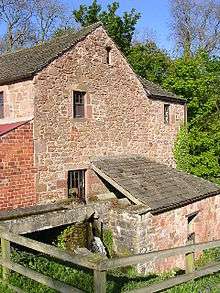Barry, Angus
Barry (Scottish Gaelic: Barraidh) is a small village in Angus, Scotland, on Barry Burn at the mouth of the River Tay. The recent completion of a bypass for the village on the A930 road from Dundee to Carnoustie is something that was originally planned before the Second World War. There is a water mill (Barry Mill) operated by the National Trust for Scotland. The village is served by Barry Links railway station. The village was formerly served by Barry primary school which closed in 2007.
| Barry | |
|---|---|
 Barry Location within Angus | |
| OS grid reference | NO536344 |
| • Edinburgh | 42 mi (68 km) SSW |
| • London | 367 mi (591 km) SSE |
| Council area | |
| Lieutenancy area | |
| Country | Scotland |
| Sovereign state | United Kingdom |
| Post town | CARNOUSTIE |
| Postcode district | DD7 |
| Dialling code | 01382 |
| Police | Scotland |
| Fire | Scottish |
| Ambulance | Scottish |
| UK Parliament | |
| Scottish Parliament | |
History
The Parish of Barry, which was originally known as Fethmoreth, Fethmure, Fettermore or Fethmuref was originally bestowed to the monks of Balmerino Abbey in Fife by Alexander II in 1230. An early record of it can be found in a proverb attributed to Thomas the Rhymer:
- The braes of Fettermore
- Hae been a gude ship's shore[1]
The monks originally managed the lands from the Grange of Barry and latterly the land was controlled by the office of the Bailies of Barry, an early holder of this position being Sir Thomas Maule of Panmure in 1511.[2]
A number of feus were granted in the Parish around that time, including Ravensby in 1539, Gedhall to David Gardyne in 1541, half of Barry Links and Cowbyres to Walter Cant in 1545 and the other half of the links to Robert Forrester in 1552.[2]

The land was annexed by the crown in the Protestant reformation following an Act of Parliament in 1587 and the Bailiery of Barry was granted by James VI as a heritable gift to Patrick Maule in 1590. Ownership of the lands was granted by the King to James Elphinstone, Secretary of State in 1599 (ratified 1605),[3][4] and was sold to George Maule, 2nd Earl of Panmure in 1667 (ratified in 1672) for £746 13s 4d.[5] The land was forfeited following James Maule, 4th Earl of Panmure's involvement in the Jacobite rising of 1715.[2]
Barry Buddon is a large training area (Barry Buddon Training Area) on the nearby dunes, adjacent to Carnoustie Golf Links.[6]
References
Notes
- Cheviot, A. (1896). Proverbs, Proverbial expressions and popular rhymes of Scotland; collected and arr., with introd., notes and parallel phrases (PDF). Paisley: Alexander Gardner.
-
Campbell, J.A. (1867). Balmerino and its abbey, a parochial history. Edinburgh: William Patterson. Retrieved 8 September 2008.
history of balmerino abbey.
- James VI (1605). "Ratificatioun in favouris of the Lord Balmirrenoch and his sone, James Elphingstoun, of thair infeftmentis of Ballumbie and Barntoun". 7 June 1605 Parliamentary Register, Edinburgh/Perth. rps.ac.uk. Archived from the original on 16 July 2011. Retrieved 11 September 2008.
- James VI (1605). "Erectioun of the abbacie of Balmirrenoch, with the landis and baroneis of Kirknewtoun and Balerno unite thairto, in ane temporall lordschip in favouris of the Lord Balmirrenoch (Erection of the abbacy of Balmerino, with the lands and baronies of Kirknewton and Balerno united thereto, in a temporal lordship in favour of James Elphinstone, Lord Balmerino)". Records of the Parliaments of Scotland. Retrieved 20 August 2009.
- "Ratification in favours of the earle of Panmuire". rps.ac.uk. 1672. Archived from the original on 16 July 2011. Retrieved 11 September 2008.
- "Barry Buddon Training Area" (PDF). Retrieved 13 April 2014.
| Wikimedia Commons has media related to Barry, Angus. |
